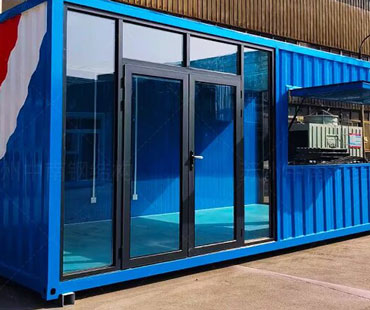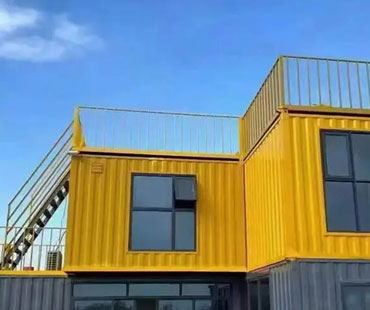As global urbanization accelerates and environmental concerns mount, the architectural landscape is undergoing a significant transformation. Among the emerging trends, container architecture stands out as a revolutionary approach that combines sustainability with innovative design.
Container architecture refers to the practice of using repurposed shipping containers as building blocks for structures, ranging from homes to commercial spaces. Originally designed for transporting goods, these steel containers have found a second life in the realm of architecture. Their inherent durability, modularity, and affordability make them an attractive option for architects and builders seeking innovative solutions to housing and space challenges.
Sustainable development is a critical focus in contemporary architecture, and container homes align perfectly with this ethos. By reusing materials that would otherwise contribute to landfill waste, container architecture promotes resource conservation and reduces the overall environmental impact of construction. This practice is particularly relevant in a world grappling with rising waste levels and the urgent need for sustainable living practices.
1.Recycling and Resource Efficiency: The conversion of shipping containers into livable spaces exemplifies the principles of recycling. Instead of sourcing new materials, container architecture utilizes existing resources, significantly lowering the carbon footprint associated with new construction.
2.Energy Efficiency: Container homes can be designed for optimal energy use. With proper insulation, natural ventilation, and the integration of renewable energy sources like solar panels, these structures can minimize energy consumption and reduce reliance on fossil fuels.
3.Water Management: Many container projects incorporate features such as rainwater harvesting systems and greywater recycling, further enhancing their sustainability credentials. This not only conserves water but also promotes responsible resource management in urban environments.
The modular nature of shipping containers allows for remarkable flexibility in design. Architects are increasingly embracing this versatility to create dynamic and aesthetically appealing structures that challenge traditional architectural norms.
1.Customizable Spaces: Container architecture enables the creation of bespoke living and working environments. Containers can be stacked, arranged, and modified to accommodate various needs, from single-family homes to multi-unit dwellings and even pop-up shops. This adaptability makes container architecture suitable for diverse contexts, including urban infill and rural development.
2.Aesthetic Appeal: The industrial aesthetic of container architecture is gaining popularity, as designers leverage the raw, minimalist look of steel to create striking visual statements. With creative finishes, landscaping, and artistic elements, container homes can be transformed into unique works of art that enhance their surroundings.
3.Community-Centric Designs: Innovative container projects often focus on fostering community engagement. By creating open spaces, communal gardens, and shared facilities, container architecture encourages social interaction and collaboration among residents. Such designs contribute to a sense of belonging and community, which is increasingly vital in urban settings.

Addressing Challenges and Misconceptions
Despite its many advantages, container architecture faces several challenges that need to be addressed for broader acceptance and implementation.
1.Regulatory Hurdles: Building codes and zoning regulations can pose significant obstacles to container architecture. Many municipalities have not yet adapted their regulations to accommodate these unconventional structures, leading to legal and logistical difficulties for developers.
2.Perception Issues: There is a prevailing misconception that container homes are temporary or substandard. Public education and successful case studies showcasing the quality and resilience of container architecture can help shift these perceptions and encourage acceptance among potential homeowners and investors.
3.Insulation and Comfort: One of the primary concerns with container homes is their thermal performance. Without proper insulation, containers can become uncomfortably hot or cold. However, advancements in insulation technologies and design strategies are helping to mitigate these issues, making container homes more comfortable and livable.
The Road Ahead
The future of container architecture holds immense potential for transforming urban landscapes and promoting sustainable living. As architects, builders, and communities continue to explore innovative possibilities, container homes are poised to become a staple in the architectural repertoire.
1.Global Impact: The principles of container architecture can be applied worldwide, particularly in regions facing housing shortages or economic challenges. By providing affordable and sustainable housing solutions, container architecture can play a crucial role in improving living conditions for vulnerable populations.
2.Technological Advancements: The integration of smart technologies in container homes promises to enhance their functionality and efficiency. Smart home systems, energy management technologies, and automated features can further optimize the living experience while minimizing resource consumption.
3.Increased Collaboration: The convergence of architects, engineers, environmentalists, and community stakeholders will be essential in driving the evolution of container architecture. Collaborative efforts can lead to more innovative solutions that address pressing societal and environmental challenges.
Container architecture represents a groundbreaking approach to modern living, merging sustainability with innovative design in a way that resonates with contemporary values. As the world faces increasing urbanization andenvironmental challenges, the adoption of container architecture could be a pivotal factor in shaping a more sustainable future. By embracing the potential of repurposed shipping containers, we can create versatile, eco-friendly spaces that not only meet the needs of today’s society but also pave the way for future generations.


